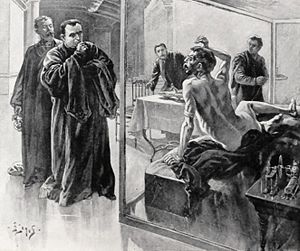The Sleeper Awakes
 Graham awakens unexpectedly | |
| Original Title: | When The Sleeper Wakes |
|---|---|
| Written by: | H. G. Wells |
| Central Theme: | |
| Synopsis: | |
| First published: | 1899 |
Struck by a strange ailment, a Victorian gentleman called Graham falls into a sudden coma. When he wakes up 203 years later, he discovers the trust set up by executors of his estate has grown so much that he is now the owner of almost everything on the planet. Under his name his trustees rule the planet, bringing in an age of total peace and startlingly advanced technology, but at a steep price -- democracy is dead, the rich are brainless and hedonistic while the poor are all but slaves overseen by brutal military police.
Broken free from the trustees prison by a politician called Ostrog, Graham finds himself stuck in the middle of an uprising as Ostrog promises to restore Graham's power and bring an end to the council's reign.
Not one of H G Wells's best known works, The Sleeper Awakes (originally published as When The Sleeper Wakes) has nevertheless survived in print to the present day, and remains one of his classic science-fiction pieces. George Orwell claimed it explicitly as an influence on Nineteen Eighty-Four, and it went on to (very) loosely inspire the Woody Allen comedy Sleeper.
- Advert-Overloaded Future: The churches we see are the main example of this - the temple district of London is an eye-searing mixture of advertisements promising salvation, ranging from posters to huge banners to giant flaming letters.
- All Just a Dream: Occasionally suggested -- if Graham has been asleep for 203 years, how can he know he isn't still asleep?
- Author Appeal: The story was written just as Wells began to shift from science fiction to socialist literature, and it shows.
- Author Avatar: Graham is a technology-loving socialist-radical artist. Sound familar?
- Bolivian Army Ending: One interpretation of the ending. Several of Ostrog's planes full of armed police have landed, and only plane capable of destroying the others, carrying Graham, has crashed.
- Corrupt Church: With rapid transit making the old parish churches obsolete, the religions have all agglomerated their churches and temples into one huge shopping district, promising to sell salvation. Theosophy is the only real-world religion that gets called out.
- The revived slave trade, meanwhile, comes from a heavily warped version of the Salvation Army, bought out by Graham's trust and turned into the Department of Labour, the defacto owner and master of the world's poor.
- Crystal Spires and Togas: Quite probably one of the Trope Maker. Everyone wears togas and jumpsuits, architecture is heavily based around columns and Greek-style statues, and the world is ruled by the Council.
- Domed Hometown: London.
- Eternal Sexual Freedom: Hinted at - as a proper Victorian gentleman, Graham wants no part.
- Future Slang: Most of it goes unexplained, as does the bizarre new half-Latin, half-Greek phonetic alphabet. We do however learn that "Word" means a soundbite, and a "capillotomist" is a barber.
- Messianic Archetype: Graham, who gets chapter-long conversation filled with religious imagery. He is, after all, lord of the world and has risen again as the saviour of his people. He's also portrayed as something of a King Arthur figure, another classic messianic character. Graham, for his part, tries to puncture this idea, claiming he won't bring a "millenium".
- Nice Job Fixing It, Villain: After the revolution London is still tense, and discontent with Ostrog's rule bubbles under the surface, but it remains peaceful. Then Ostrog announces that thousands of military police and torturers are being flown in to police London. A few hours later, London is in uproar and Ostrog has been forced out. In Wells's own words "The thesis is that he is a man of enormous knowledge and capacity. But he bungles his situations incredibly.
- No Ending: In the revised version, we never find out whether the revolution managed to completely topple Ostrog.
- Nu Speling: The future has a new alphabet, based on a mixture of Latin and Greek, which is supposed to be phonetic.
- Propaganda Machine: The Babble Machines, which shout a mixture of news and ridiculous slogans ("Galloop, Galloop!").
- Ramming Always Works: Aeroplanes ramming other aeroplanes. Yeah...
- Reality Subtext: Vicars and bishops are revealed to be polygamous - at the time the book was written, the Church of England Synod was debating whether ministers should be allowed to marry at all.
- Revised Ending: When The Sleeper Wakes makes it fairly clear Ostrog will be overthrown. When it was edited as The Sleeper Awakes, these references were cut, and it's no longer clear who wins the battle for London.
- Rip Van Winkle: The story begins when Graham falls asleep for 203 years.
- Science Marches On: The first draft of the book was published in 1899, and portrays a future where all aeroplanes are catapult launched and no aeroplane has ever fought another in the air before. By the time it was republished in 1924, Wells had to add a footnote to the chapter explaining "These chapters were written 15 years before there was any fighting in the air" and his preface apologises "The air fighting reads queerly now".
- The Hero Dies: Well, the story slams to a halt when Graham's plane crashes.
- We Will Have Euthanasia in the Future: "Euthanasy". Played with, to an extent -- Euthanasia is kept expensive so that only the rich can have it; the poor have to stay in servitude.
- We Will Use Manual Labor in the Future: The book subverts this idea -- although the future society has a huge slave class, Graham realises that the slaves are weak and lack muscle. Their role is simply to supervise the machinery.